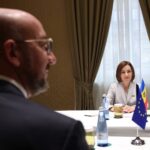This year’s Web Summit wasn’t just a platform for start-ups and tech titans—it was a stage for profound reflection on the intersection of technology, society, and freedom.
Ten years ago, less than 40 per cent of the world’s population lived under an autocracy. Today, that figure has risen to more than 70 per cent—5.7 billion people—according to Leopoldo López, the leader of the Venezuelan opposition, who spoke in Lisbon.
It is a staggering statistic, and one that raises urgent questions about the trajectory of global governance and the role of technology in either enabling or resisting authoritarianism.
Yulia Navalnaya, the widow of Russian opposition leader, anti-corruption activist, and political prisoner Alexei Navalny, took this idea further. She argued that autocrats such as Vladimir Putin cannot be defeated by traditional means. Instead, democracy requires innovation—new tools, strategies, and ideas that can outpace the oppressive systems designed to stifle dissent and suppress freedom.
Technology has the potential to be democracy’s greatest ally, but only if we intentionally design it to empower, protect, and connect people.
Technology as a force for good
Over the past decade, we have seen how technology can both challenge and reinforce systems of control. Social media platforms, for example, have given activists a voice, yet the same platforms are weaponised by regimes to spread disinformation and manipulate public opinion.
What is needed now is a reinvention of how we approach technology—not as a neutral tool, but as a force for good. Imagine platforms designed not just to connect, but to protect.
Innovation in encryption and secure communication can give dissidents a lifeline, allowing them to organise without fear of surveillance. Blockchain technologies could ensure election integrity, making it harder for authoritarian regimes to manipulate outcomes.
Advances in artificial intelligence could help identify and counteract propaganda in real-time, providing citizens with reliable information amidst a sea of misinformation.
But reinvention goes beyond technology. It requires a shift in mindset, especially within the tech community. Developers, investors, and entrepreneurs must see their work not just as a pursuit of profit, but as a responsibility to the global community.
Technology must prioritise values over virality, and empathy over engagement metrics. It’s about building systems that strengthen democratic institutions, support grassroots movements, and give voice to the voiceless.
Addressing societal challenges
One key example of this reinvention is the growing field of civic tech—innovations specifically aimed at addressing societal challenges. From platforms that enable whistleblowers to safely report corruption to tools that facilitate citizen participation in policymaking, civic tech demonstrates the immense potential of technology to drive systemic change.
However, its impact is often limited by a lack of funding and attention compared to more commercially lucrative ventures. This is where the global tech community must step up, investing not just money but also talent and resources into solutions that can tip the scales in favour of freedom.
López’s and Navalnaya’s words resonate not only as a call to action but as a reminder that the fight for democracy is one we all share. Whether through supporting technologies that promote transparency, advocating for ethical standards in AI, or simply holding platforms accountable for their role in society, we each have a part to play.
Technology is at a crossroads. It can either be a tool for oppression or a weapon for freedom. The choice lies not with autocrats, but with innovators.
If we want the next decade to tell a different story, we must begin now. Let this be a reminder that technology’s greatest promise lies not in its speed or scale, but in its ability to inspire and empower humanity toward a more just and peaceful world.







